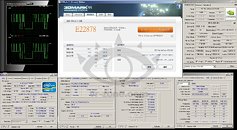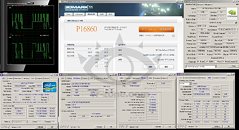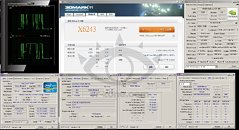Monday, March 19th 2012

GeForce GTX 680 SLI Performance Surfaces
NVIDIA's big GeForce GTX 680 launch is just around the corner, but performance figures are already trickling in. Last week, we were treated to a wide range of benchmarks covering a single GeForce GTX 680. Today, VR-Zone posted a performance-preview of the GeForce GTX 680 in 2-way SLI configuration. A set of two GTX 680 cards were put through 3DMark 11 in Entry, Performance, and eXtreme presets. It should be noted here, that the GTX 680 cards were clocked at 1150 MHz core, and 1803 MHz (7.20 GHz effective) memory.
In the Entry preset, GTX 680 2-way SLI scored E22878; it scored P16860 in Performance preset; and X6243 in eXtreme. 2-way SLI of GTX 680 should be fit for 2560x1440/1600 resolution gaming. The rest of the test-bench consisted of Intel Core i7-3930K six-core processor clocked at 5.00 GHz, with 16 GB of quad-channel DDR3-2133 MHz memory, and ASUS ROG Rampage IV Extreme motherboard.
Source:
VR-Zone Chinese
In the Entry preset, GTX 680 2-way SLI scored E22878; it scored P16860 in Performance preset; and X6243 in eXtreme. 2-way SLI of GTX 680 should be fit for 2560x1440/1600 resolution gaming. The rest of the test-bench consisted of Intel Core i7-3930K six-core processor clocked at 5.00 GHz, with 16 GB of quad-channel DDR3-2133 MHz memory, and ASUS ROG Rampage IV Extreme motherboard.



43 Comments on GeForce GTX 680 SLI Performance Surfaces
The bandwidth is way more impressive on this
:eek:
GTX 280 : 512 bit / 8 x 2214MHz effective = 141.7 GB/sec
GTX 560Ti : 256 bit / 8 x 4008MHz effective = 128.27 GB/sec
I knew this whole upgrading and architecture refinement was bogus...
If a couple of 7950s can do this, so can a couple of 7970s.
The 680 can do way more then this (i'm assuming) and so can 7970s: which one will be on top? We'll find out very soon!!!
Kudos to you Nvidia, I honestly can't believe Nvidia are trying to hoodwink enthusiasts eyes with a mid range part overclocked and rebranded high end. :laugh:
So, more or less matches AMD's top SKU (resolution dependant I presume) with 20% less die space...the very definition of "fairly lame"Um, haven't AMD already set the price for this level of single GPU performance? Whose to say that AMD wouldn't be looking at a similar spec to the GTX 680 if they hadn't belatedly decided that a higher level of GPGPU functionality might be a good idea after all (I'm assuming that the wider memory bus and compute might come at a cost to die area)
The real 680-probably 780 later in the year will have a much bigger core and would have trounced the 7970 at much lower clocks. Nvidia obviously are not ready with that core so they get a highly clockable mid range core and bang it out as high-end with a hefty price tag to go with it, only mugs will look at this card.
It is hardly surprising that 1000 core 680 gets a bigger score than the 780 core 580, I mean I know of many mid-high end cards that can trounce the 580 in 3DM11 when clocked up the ass. For a new chip on a new design it is undweling to say the least.
Nvidia should have had the decency to put the core out as the mid range chip it is regardless of performance, doing what they are doing just makes them look like the assholes they are.
Vendor B releases the card after Vendor A. By all accounts the newer card is possibly a slight bit faster.
Vendor B has now released a card that (in cases) is beating the previous high end card. Vendor B now has the fastest single gpu in history.
Low-----Mid-----High.
If we look at the simple 3 words above it can be viewed as a scale of low to high. At present the card vendor B is releasing is going to be the card that sits right at the right hand side, i.e. the highest performing single gpu in history. At present, vendor B has made no inference of any higher spec'ed single gpu card in it's immediate future.
Vendor B has released a high end card. It is absolutely illogical to suggest GK104 is a mid range card when it is
A) The fastest (contentious issue) card out there
B) Priced as such
C) Has no immediate successor (NOBODY knows if/when GK 110 is coming)
People that keep on saying GK104 is mid range need a reality check. Any product that is the fastest in it's current line up is it's high end product, irre-fucking-spective of it's production cost, die size or anything else.
If I could create a gfx card that cost me 2 cents to make but blew everything away I would market it at the cost higher than my competitors best card. It's called business. People that don't grasp that ought to stick to charity work and idealistic tree hugging.
2. Clocks speed of 1006: Everyone jumped on this band wagon because videocardz.com listed the GTX 680 as of having those clocks. It has always been a rumor stemming from there. I am not saying the final clocks won't be above 706 but what I am saying is NDA hasn't been lifted and everyone on every tech site is acting like these cards have already been released and everything about them is fact.
3. Yes the HD 7970 can clock higher and score higher.... But like everyone else points out.... the GTX 680 is still very new and unreleased. Give it till it really releases so we have a fair comparison. No point in arguing a card we have no idea what the real specs are.
The one thing that I do notice that is consistent from site to site reported about these cards is..... That the HD 7970 competes hand in hand with the GTX 680 so I would expect that.
1536 dual-issue FMADD/scalar + (1:6) 256 sfu is a very efficient 32 ROP design.
A 1792 design where a vec16 unit can do 4 special functions and each shader does 2 flops (which equals 1536 shaders if doing 1:6 special function ops) is an equally impressive option.
One calls it a 680. One calls it a 7950.
THEY. ARE. SIMILAR.
Want more texture units, a smaller card, or like lime green? Get a 680.
Want more bandwidth, larger buffer for high-resolution, or prefer red? Get a 7950.
Please W1z, do a clock-for-clock (and or clock/equal bw) comparison in your review. Actual power consumption in a game included ('peak') would be great as well since both companies do tdp differently. I know it's not TPU's style, and people will likely bitch about comparing overclocking of one architecture vs closer to stock for the other, but I imagine what it really boils down to (other than fine-grained differences) is what each sku is capable...especially at these price tags. 7950's stock core speed/performance is such a misnomer it's sickening. Obviously it is conservatively clocked to make 7970 look better and (imo) so the 8850 can perfectly replace it's performance at under 150w. A similar story I believe is true for 7970 (judging by actual power consumption and the tdp space between pitcairn powertune rating and the pci-e power specs). nVIDIA, intelligently so, is exploiting a marketing hole and it's (again, imo) kind of bullshit to to compare architectures in that fashion. nVIDIA almost appears to be counting on it and someone needs to out the fallacy they are going to use with 680.
I imagine overall, when it comes down to it brass tacks, it's very close.
It does not make any sense. Each core and the frequency the manufacture decided to run it in.
*Cough BS Cough*